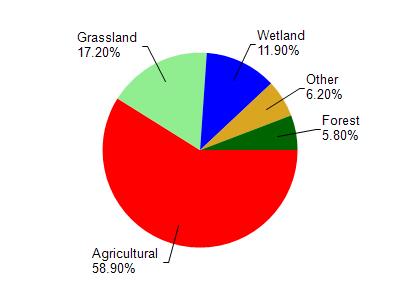Dodge
No
No
No
Fish and Aquatic Life
Overview
Kekoskee Millpond is a shallow silt bottomed impoundment of the East Branch Rock River created by a 12-foot dam at Kekoskee. Extensive growths of marsh vegetation which provided habitat for muskrats and waterfowl have long since disappeared. The fishery is limited to carp, bullheads and an occasional northern pike. Although navigable access via the river is possible, no public access facilities exist on the pond itself. Pollution from municipal and industrialsources in Mayville is largely responsible for the severe winterkill which occurs annually, and with the arrival of anaerobic conditions it is common for local residents to complain of the putrid odors given off by the water spilling over the dam. Erosion within the watershed has resulted in an increased rate of siltation, and nowhere is the problem more evident than on the slopes adjacent to the pond itself. These badly overgrazed hills reveal poor land-use practices all too common to Dodge County. At the time of this writing, the Kekoskee Millpond is without a doubt the most mistreated body of water in the county.
Surface Acres = 52, S.D.F. = 2.17, Maximum Depth = 5 feet
Source: 1965, Surface Water Resources of Dodge County Kekoskee Millpond T12N, R16E, S10
Date 1965
Author Aquatic Biologist
Condition
Wisconsin has over 84,000 miles of streams, 15,000 lakes and milllions of acres of wetlands. Assessing the condition of this vast amount of water is challenging. The state's water monitoring program uses a media-based, cross-program approach to analyze water condition. An updated monitoring strategy (2015-2020) is now available. Compliance with Clean Water Act fishable, swimmable standards are located in the Executive Summary of Water Condition in 2018. See also the 'monitoring and projects' tab.
Reports
Recommendations
Shoreland Ordinance
Dodge County Planning & Development Department is interested in revising the Dodge County Shoreland Zoning Regulations and adopting a "waterway" classification system to better regulate and manage the county's water resources.
Management Goals
Wisconsin's Water Quality Standards provide qualitative and quantitative goals for waters that are protective of Fishable, Swimmable conditions [Learn more]. Waters that do not meet water quality standards are considered impaired and restoration actions are planned and carried out until the water is once again fishable and swimmable
Management goals can include creation or implementation of a Total Maximum Daily Load analysis, a Nine Key Element Plan, or other restoration work, education and outreach and more. If specific recommendations exist for this water, they will be displayed below online.
Monitoring
Monitoring the condition of a river, stream, or lake includes gathering physical, chemical, biological, and habitat data. Comprehensive studies often gather all these parameters in great detail, while lighter assessment events will involve sampling physical, chemical and biological data such as macroinvertebrates. Aquatic macroinvertebrates and fish communities integrate watershed or catchment condition, providing great insight into overall ecosystem health. Chemical and habitat parameters tell researchers more about human induced problems including contaminated runoff, point source dischargers, or habitat issues that foster or limit the potential of aquatic communities to thrive in a given area. Wisconsin's Water Monitoring Strategy was recenty updated.
Grants and Management Projects
Monitoring Projects
| WBIC | Official Waterbody Name | Station ID | Station Name | Earliest Fieldwork Date | Latest Fieldwork Date | View Station | View Data |
|---|
| 861900 | Kekoskee Millpond | 10001275 | Kekoskee Millpond | 7/27/1999 | 9/12/2016 | Map | Data |
| 861900 | Kekoskee Millpond | 10017806 | Rock River-East Branch -- Access | 6/5/2012 | 9/30/2013 | Map | Data |
|

Watershed Characteristics
Kekoskee Millpond is located in the East Branch Rock River watershed which is 198.99 mi². Land use in the watershed is primarily agricultural (58.90%), grassland (17.20%) and a mix of wetland (11.90%) and other uses (12.00%). This watershed has 306.48 stream miles, 292.02 lake acres and 16,059.62 wetland acres.
Nonpoint Source Characteristics
This watershed is ranked High for runoff impacts on streams, High for runoff impacts on lakes and High for runoff impacts on groundwater and therefore has an overall rank of High. This value can be used in ranking the watershed or individual waterbodies for grant funding under state and county programs.However, all waters are affected by diffuse pollutant sources regardless of initial water quality. Applications for specific runoff projects under state or county grant programs may be pursued. For more information, go to surface water program grants.